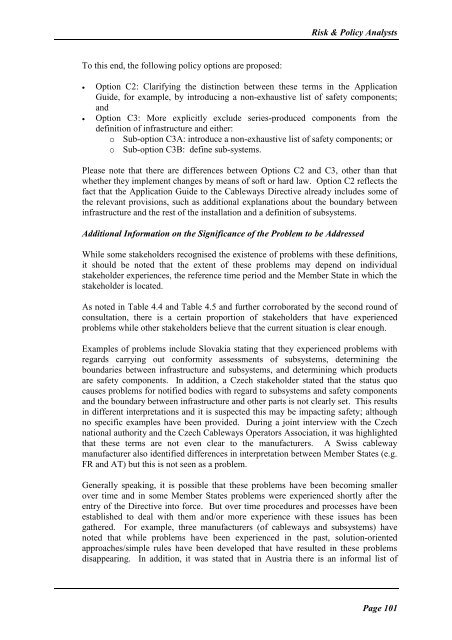Cableways Impact Assessment Study - Final Report - saferail.nl
Cableways Impact Assessment Study - Final Report - saferail.nl
Cableways Impact Assessment Study - Final Report - saferail.nl
You also want an ePaper? Increase the reach of your titles
YUMPU automatically turns print PDFs into web optimized ePapers that Google loves.
Risk & Policy Analysts<br />
To this end, the following policy options are proposed:<br />
<br />
<br />
Option C2: Clarifying the distinction between these terms in the Application<br />
Guide, for example, by introducing a non-exhaustive list of safety components;<br />
and<br />
Option C3: More explicitly exclude series-produced components from the<br />
definition of infrastructure and either:<br />
o Sub-option C3A: introduce a non-exhaustive list of safety components; or<br />
o Sub-option C3B: define sub-systems.<br />
Please note that there are differences between Options C2 and C3, other than that<br />
whether they implement changes by means of soft or hard law. Option C2 reflects the<br />
fact that the Application Guide to the <strong>Cableways</strong> Directive already includes some of<br />
the relevant provisions, such as additional explanations about the boundary between<br />
infrastructure and the rest of the installation and a definition of subsystems.<br />
Additional Information on the Significance of the Problem to be Addressed<br />
While some stakeholders recognised the existence of problems with these definitions,<br />
it should be noted that the extent of these problems may depend on individual<br />
stakeholder experiences, the reference time period and the Member State in which the<br />
stakeholder is located.<br />
As noted in Table 4.4 and Table 4.5 and further corroborated by the second round of<br />
consultation, there is a certain proportion of stakeholders that have experienced<br />
problems while other stakeholders believe that the current situation is clear enough.<br />
Examples of problems include Slovakia stating that they experienced problems with<br />
regards carrying out conformity assessments of subsystems, determining the<br />
boundaries between infrastructure and subsystems, and determining which products<br />
are safety components. In addition, a Czech stakeholder stated that the status quo<br />
causes problems for notified bodies with regard to subsystems and safety components<br />
and the boundary between infrastructure and other parts is not clearly set. This results<br />
in different interpretations and it is suspected this may be impacting safety; although<br />
no specific examples have been provided. During a joint interview with the Czech<br />
national authority and the Czech <strong>Cableways</strong> Operators Association, it was highlighted<br />
that these terms are not even clear to the manufacturers. A Swiss cableway<br />
manufacturer also identified differences in interpretation between Member States (e.g.<br />
FR and AT) but this is not seen as a problem.<br />
Generally speaking, it is possible that these problems have been becoming smaller<br />
over time and in some Member States problems were experienced shortly after the<br />
entry of the Directive into force. But over time procedures and processes have been<br />
established to deal with them and/or more experience with these issues has been<br />
gathered. For example, three manufacturers (of cableways and subsystems) have<br />
noted that while problems have been experienced in the past, solution-oriented<br />
approaches/simple rules have been developed that have resulted in these problems<br />
disappearing. In addition, it was stated that in Austria there is an informal list of<br />
Page 101
















